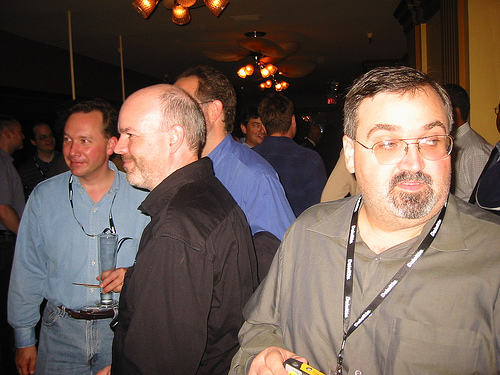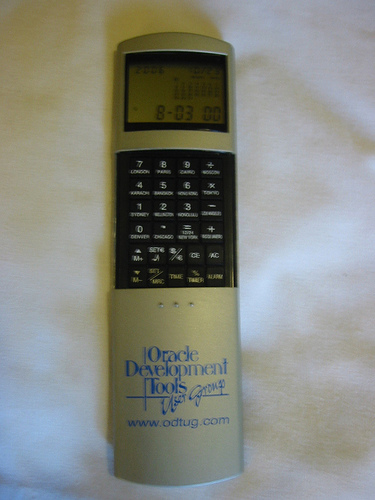Oracle Open World Days 1,2 - Database Roadmaps
I'm sitting now in the Speaker Ready-room down in the Moscone South mezzanine, in between sessions on Oracle Database 11g and the BI Suite Enteprise Edition & Standard Edition presentations later this afternoon. The morning started off with the Chuck Rozwat keynote on Oracle's database technology, a run through of the new 10g products launched this year (Content Database, Records Database, BI Suite EE) and with a formal announcement of Oracle Database 11g, currently in beta and with a production release during the second half of 2007.
Rozwat mentioned some 482 new features in 11g, but with no specific details in this presentation. We got a look at the new Enterprise Manager 10gR2 which presents a "BI Dashboard for DBAs", using existing Enterprise Manager technology (i.e. not Discoverer or BI EE) - this seems to be a rejig of the information currently within OEM, but presented in more of a "DBA cockpit" format with key indicators highlighted and presented one one screen, drill-throughs to graphs and more detailed data, more of a refinement of OEM to include features more commonly found in BI dashboards, but aimed at DBAs and containing metrics and KPIs on how the database is performing.
One interesting thing that Rozwat did show was an example of BI Suite Enterprise Edition embedded in an Oracle application - an Expense Approvals application that brought up an embedded BI EE dashboard to help the user work out whether to approve or decline an expense claim - this looks like the first concrete example of how Oracle will start using BI EE functionality in it's e-Business Suite applications. Quite interesting.
After the Rozwat presentation I took myself along to one by Andy Mendelsohn, SVP of Database Product Development, on "The Future of Database Technology". I took this to be a session on what's coming up with Oracle Database 11g, which was what the session more or less turned out to be although like the Rozwat session, details were again fairly thin on the ground. Anyway, some of the new features in 11g previewed in the session included:
- A new data warehouse initiative called "Oracle Information Appliance", a package of hardware and software offered by third-parties (the first one being Panta Systems) that aims to provide a turnkey, ready-to-run DW appliance based on commodity servers, RAC, ASM and 10g. This is obviously aimed at the market currently serviced by companies such as Netezza, and the presentation included cost comparisons showing the Oracle solution as being more powerful and cheaper than the Netezza solution, plus it's not restricted to just DW applications.
- ILM Assistant, a Application Express utility downloadable from OTN that leverages partitioning, compression and 10g to help customers move less-used data onto lower cost storage.
- New partitioning schemes coming with 11g, including more ways to combine range, list and hash partitioning, plus new schemes such as REF (creates partitioning scheme based on another table that has a FK relationship to the table being partitioned), Interval (automatic creation of time-based partitions), Virtual Column (partitioning based on a function - I wonder if "virtual columns" is a general feature coming with 11g?), and a new Partition Advisor.
- Change Assurance capabilities, where new features in 11g will allow you to deploy a new database application, have the existing version run until such time as you're happy with the new release, and then have users switch over to the new one with no downtime. This idea was then extended to include online, live hot-patching of the Oracle database. Some of the new technologies introduced here included Editioning (creating versions of tables associated with an edition of an application), Editioning Views and Cross-Edition Triggers, triggers that copy across data going into the old but currently running version of the application, into the new version that's currently being tested but has yet to go live.
- Automatic Diagnostic Repository, a feature that collects (like AWR) diagnostic data for later analysis and uploading to Oracle Support - aimed at making the SR process easier by automatic the collection of diagnostic data. I wonder if this will be open to non-Oracle support use, i.e. can we use it in conjuntion with AWR to better diagnose what's going on with the database, to help us "automatically instrument" the database and the server platform?
- There was also a very quick mention of something called "Next Generation OLAP", but frustratingly no real details - but more on this in a minute.
- Partitioning, used by 100% of the 10TB+ customers,
- Parallel Query, again used by 100%
- Compression, 88%
- Materialized Views, 67%
- Virtual Private Database, 64%
- Read-Only Tablespaces, 44%
- Automatic Storage Management, 36%
- RMAN, 33%
- Database Resource Manager, 32%
The presentation then went on to give a little bit of detail on what's coming up with Oracle OLAP - apparently the focus within 11g is to make OLAP capabilities more relevant and more available for all types of data warehouse DBA and user through improvements to the SQL interface - my take on this is that analytic workspaces will be easier to create through regular DDL, and you'll be able to query them just like MV summaries - either the MV and AW technologies will start to merge, you'll be able to swap out regular MVs for analytic workspaces, maybe it'll become easier to get AWs to work with query rewrite without having to go through all the steps to get query equivalence to work. We'll have to wait and see.
Finally, there were some more details on the roadmap for OWB. The Sunopsis acquisition was mentioned, and one of the first priorities for the OWB team is to take the heterogenous connectivity features in Sunopsis and embed them in OWB - presumably to replace the current way of doing it, using TNSNAMES.ORA and LISTENER.ORA files and the Generic Connectivity method, something that's very tricky to set up. Other plans for OWB include making it more attractive for customers with non-Oracle target systems (again, probably using Sunopsis technology), enabling OWB to participate in Service Orientated Architectures - calling OWB mappings from SOA applications, and calling SOA processes from OWB mappings - and support for Real-Time data loading, something that was originally planned for the current Paris release but that was pulled during the beta process.
Anyway, that's it for the morning. Last night was the Oracle Magazine and OTN ACE's Appreciation Night, where I got to meet up again and chat with people such as Tom Kyte, Steven Feuernstein, Steve Muench and Duncan Mills, plus it gave me a chance to meet fellow ACEs and bloggers such as Lewis Cunningham, Eddie Awad and Laurent Schneider.

Finally, along with all the swag and goodies that you get when you first register, I got a speaker gift from ODTUG for doing my presentation - it looks like a cross between an air-conditioning remote control unit and a calculator, and when I first opened it and pulled out the battery protector, it played a tune for about thirty seconds and then went silent, and nothing I did after this could get it to play the tune again. Here's a picture of it fully opened, and here's another with the cover retracted.

Anyway, I'm off now for Kurt Wolff's "Oracle Business Intelligence Suite Enterprise Edition Tips and Tricks", followed by a presentation on Oracle's Business Intelligence Roadmap. More details later.